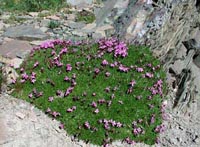Resource Library
Plant of the Week: Rose Campion
The University of Arkansas System Division of Agriculture does not promote, support or recommend plants featured in "Plant of the Week." Please consult your local Extension office for plants suitable for your region.
Plant of the Week
Rose Campion
Latin: Corylopsis platypetala

While standing atop Swift Current Mountain on the Continental Divide overlooking the grandeur of Glacier National Park, I finally understood why rock gardening attracts me.
There at my feet was a miniature garden of squatty, low-growing cushions of flowers only a couple inches tall. Each was a perfect harmony of form, function and beauty adapted to survive in this inhospitable world. One of the showiest was a little cushion plant, Rose Campion (Silene acaulis), with startlingly green leaves topped with tiny pink flowers.
Rose Campion is a member of the carnation family with a circumpolar range in the mountains of the northern hemisphere. In North America, it grows in the arctic region and down the spine of the Rockies. It forms dense, compact mats to 2 inches tall with opposite, linear leaves to a half-inch long. In rocky soil, they grow in mats ranging from a few inches across to as large as a turkey platter.
The solitary blossoms are up facing, pink and five-petaled, easily showing their relationship to the garden pinks. The flowers are borne on short stems just above the foliage and appear in July and early August in their mountain home.
Rock gardening developed as a hobby in the late Victorian period when the industrial revolution created enough wealth among the middle class to permit that fine institution, the summer vacation, to develop. You had two choices for getting away from the summertime heat of the cities – you could go to the beach or to the mountains.
Mountain climbing became popular in the European Alps during this period, and it wasn't long before climbers began bringing back seeds from mountain meadows and rocky ridge tops. Most early attempts at growing this alpine flora were unsuccessful, but eventually gardeners began to develop specialized techniques for growing these difficult plants in the garden.
In addition to the new plants, a new garden art form - rock gardening - emerged. Rock gardens were intended to simulate natural conditions with rocky outcrops creating the backdrop for the tiny plants in the garden.
Rock gardening reached America in the early 20th century. In his 1928 book, The Garden Lover, L. H. Bailey says; "There can scarcely be a movement for rock-gardening, for a real rock garden is a personal accomplishment of years of patient effort and it is born of a closer knowledge of plants than most other forms of gardening."
The American Rock Garden Society formed in 1934 (now called the North American Rock Garden Society) but has never grown much beyond 5,000 members, and about 40 percent of these are from other parts of the world. For me, rock gardening remains an elusive goal, but one with which I have amused myself for over 25 years.
Most of the plants I grow from the seeds distributed by the rock garden society are dismal failures. This record is not especially alarming to me, for the process of discovery is part of the fun. I learn as much by discovering what won’t grow as what will.
After seeing Rose Campion in full glory on a mountain top, I will again attempt to grow it in my garden. Realistically, the chances of growing this alpine in the muggy, hot, poorly drained soils of Arkansas are slim, but I will try. Maybe this time I’ll provide just the right combination of crushed rocks and wintertime protection to get it to bloom. Hope springs eternal in the heart of all gardeners.
By: Gerald Klingaman, retired
Extension Horticulturist - Ornamentals
Extension News - August 26, 2005
The University of Arkansas System Division of Agriculture does not maintain lists of retail outlets where these plants can be purchased. Please check your local nursery or other retail outlets to ask about the availability of these plants for your growing area.